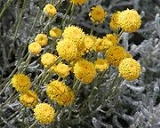
Santolina chamaecyparissus
Encyclopedia
Cotton Lavender or Gray Santolina (Santolina chamaecyparissus, Linn., syn. S. incana, Lam.) is a flowering plant
in the family
Asteraceae
, native to the western and central Mediterranean region.
used to expel intestinal parasites
. An oil used in perfumery can also be extracted from the plant. Branches may be hung up in wardrobes to repel insect, and leaves are also suitable for use in pot pourri and in herbal tobacco substitutes.
Flowering plant
The flowering plants , also known as Angiospermae or Magnoliophyta, are the most diverse group of land plants. Angiosperms are seed-producing plants like the gymnosperms and can be distinguished from the gymnosperms by a series of synapomorphies...
in the family
Family (biology)
In biological classification, family is* a taxonomic rank. Other well-known ranks are life, domain, kingdom, phylum, class, order, genus, and species, with family fitting between order and genus. As for the other well-known ranks, there is the option of an immediately lower rank, indicated by the...
Asteraceae
Asteraceae
The Asteraceae or Compositae , is an exceedingly large and widespread family of vascular plants. The group has more than 22,750 currently accepted species, spread across 1620 genera and 12 subfamilies...
, native to the western and central Mediterranean region.
Uses
Cotton Lavender has many potential uses. Most commonly, the flowers and leaves are made into a decoctionDecoction
Decoction is a method of extraction, by boiling, of dissolved chemicals, or herbal or plant material, which may include stems, roots, bark and rhizomes. Decoction involves first mashing, and then boiling in water to extract oils, volatile organic compounds, and other chemical substances...
used to expel intestinal parasites
Intestinal parasite
Intestinal parasites are parasites that populate the gastro-intestinal tract in humans and other animals. They can live throughout the body, but most prefer the intestinal wall. Means of exposure include: ingestion of undercooked meat, drinking infected water, and skin absorption...
. An oil used in perfumery can also be extracted from the plant. Branches may be hung up in wardrobes to repel insect, and leaves are also suitable for use in pot pourri and in herbal tobacco substitutes.

